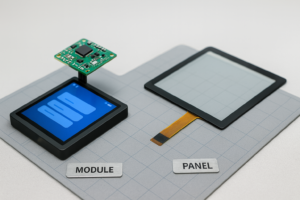A Simpler Approach to Capacitive Touch for Modern Human-Machine Interfaces (HMI)
As smart electronic devices continue to advance, incorporating Simplified Capacitive Touch Sensing in human-machine interfaces (HMI) has consequently become more important in our daily lives. Furthermore, touch-sensing technology, a key part of HMI, is also moving forward quickly.
Currently, the two main types of touch technology are resistive and capacitive. However, capacitive touch has seen huge growth in recent years. In fact, Simplified Capacitive Touch Sensing has become the top choice for many products because of its key benefits: no mechanical parts to wear out, a long life, high sensitivity, a space-saving design, and support for many touch gestures. As a result, manufacturers are constantly releasing new ICs (Integrated Circuits) to make development even easier for hardware designers.
How Capacitive Touch Works
Most IC-based capacitive touch sensors work in one of two ways:
- From Capacitance to Voltage: First, this method converts changes in capacitance into changes in voltage. Then, a special internal analog-to-digital converter samples this voltage to figure out the final capacitance value.
- From Capacitance to a Digital Count: The second method translates capacitance changes into a digital count. In this case, the system uses a triangular wave signal to charge and discharge an external electrode. By measuring the signal’s period, the system can then accurately find changes in the electrode’s capacitance.
Making Hardware Design Easier
For example, using an MCU with a dedicated touch module, like a Touch Sensing Input (TSI), makes hardware design much simpler. Simplified Capacitive Touch Sensing not only cuts development costs but also makes the hardware circuit less complex, which leads to a more stable and reliable system.
1. Designing the Touch Interface The built-in TSI module makes hardware design much simpler. Specifically, you just need to connect an external electrode to the right TSI channel through a current-limiting resistor. This resistor is important because it protects the MCU from damage by stopping currents that are too high. You should choose the right resistor value based on your project’s needs.
2. Touch-Keypad PCB Layout For the electrodes, you can use a copper board coated with a non-conductive layer. We then designed a square touch keypad by joining several triangular copper pads. Finally, we connected each triangular pad to a specific channel on the TSI module.
Making Software Design Faster
The TSI module doesn’t just simplify hardware; it also streamlines software development. For instance, you can turn on the touch feature by setting up a few registers and writing simple code for calibration and interrupts. This makes the software design process much easier. Our system uses an interrupt-based method, which is integral to Simplified Capacitive Touch Sensing. This means the TSI module automatically scans for touches and only triggers an interrupt when it finds one, which reduces the CPU’s workload.
1. Setting Up the TSI Module To initialize the TSI module, you first need to set up its registers based on your hardware design. The key registers include the General Control and Status Register (TSI0_GENCS), the Scan Control Register (TSI0_SCANS), and the Channel Enable Register (TSI0_PEN). In addition, you also need to set up the K60 MCU’s internal clock and pin settings.
2. Calibrating the TSI Module After setup, you must calibrate the TSI module to accurately detect touches. First, the system measures the starting capacitance when no finger is present. The system then uses this value to set high and low limits by adding and subtracting a custom deadzone value. These limits define the normal range. An interrupt triggers only when the measured capacitance goes beyond this range, which signals a touch.
3. Handling TSI Module Interrupts Finally, the TSI module supports several interrupt types, such as error, timeout, end-of-scan, and out-of-bounds interrupts. It’s important to note that in the K60 MCU’s interrupt system, all of these share the same interrupt vector (number 99).
The Best All-in-One Solution: The TD Series
The TD series of all-in-one capacitive touch computers is the easiest and most natural device for human-machine interaction. It brings together the best of Simplified Capacitive Touch Sensing, computing power, multimedia, audio, and networking into one sleek design. Moreover, with a completely flat and smooth surface, it provides an outstanding touch and search experience. Ultimately, it allows users to find and show information quickly, making HMI truly easy to use.
.png)



